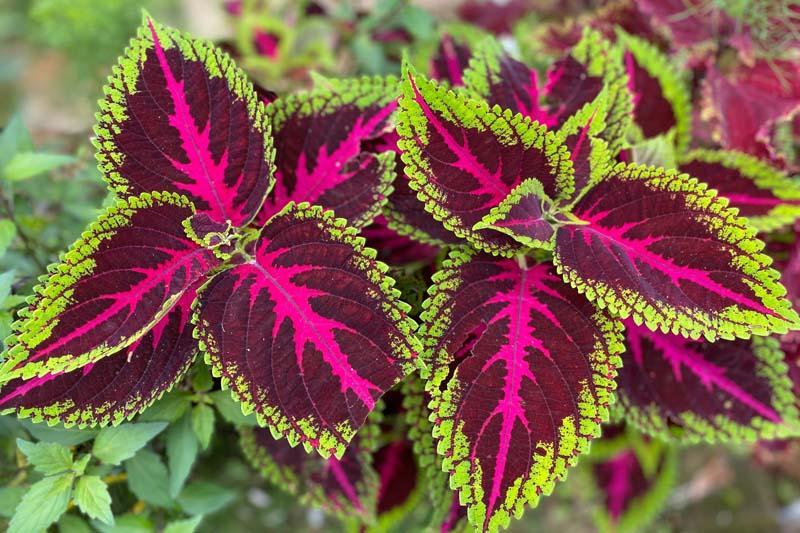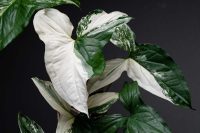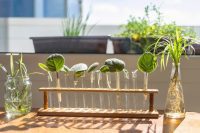At a glance What is coleus? Care How to grow coleus Propagating coleus Pests and diseases Toxicity
At a glance
| Family | Lamiaceae |
| Botanical name | Plectranthus scutellarioides syn. Solenostemon scutellarioides |
| Common names | Painted nettle, Flame nettle, Coleus, Indian borage, Bread and butter plant, Indian thyme, Country borage, East Indian thyme, Spanish thyme, Stinging thyme |
| Plant type | Herb |
| Lifespan | Perennial, Annual |
| Soil | Rich, moist, well-drained |
| Mature height | 60 cm-100 cm (23-39 inches) |
| Sun exposure | Full sun to moderate shade |
| Soil pH | Mildly acidic to neutral (6.0 to 7.0) |
| Leaf colour | Varies |
| Flower colour | Purple, blue, white |
| Symbolism | Beauty, good health, growth, tolerance |
| Toxicity | Mildly toxic to cats, dogs, horses, humans |
| Toxic properties | Volatile essential oils (coleon O and diterpene coleonol) and irritant sap |
What is coleus?
Coleus is a genus of flowering tender perennials native to Malaysia and South East Asia. Its multicoloured, decorative foliage makes it a popular garden and houseplant. Coleus is a member of the mint family and has traditional square stems, sweetly scented tubular flowers and oval-shaped leaves with crenate or lobate margins. The name comes from the Greek word koleos, which means sheath and refers to the male portions of the flowers.
Coleus was first introduced to Europe in 1951 by Dutch horticulturist Karl Ludwig Blume who found coleus being cultivated in the Dutch colony of Java. During the 19th century, coleus was a hugely popular plant that fetched high prices from plant lovers and collectors. By the early 1900s, popularity dwindled but experienced a resurgence by the 1950s when it became popular as a decorative houseplant. There are currently over 300 species of coleus and 1500 varieties in a rainbow of colours including green, pink, red, orange and yellow.
In the garden, coleus is a flamboyant foliage plant that goes well in both garden beds or containers, offering a beautiful display of colour.

Coleus typically has scalloped leaf margins, but some varieties (known as duck foot coleus), have lobated leaf margins.
Care

Coleus is a low-maintenance plant that readily adapts to various lighting conditions. While traditionally favoured for partial shade, many modern varieties thrive in full sun. Ideally, coleus plants flourish in dappled shade or locations with morning and afternoon protection. Insufficient sunlight can dull the vibrancy of the leaves, while excessive exposure might bleach them.
The soil should be moist, but not wet. Coleus will wilt when they are thirsty, but I have found they make a quick recovery once they are watered. As with all plants, water more during the warmer months. If the plant is continually drying out, it is a good indicator that it is time to move to a bigger pot.
Pinching back coleus is a tried-and-true method to encourage a fuller, more robust growth pattern. By doing this, you’re not only ensuring that the plant remains dense and bushy but also combatting the undesirable elongated growth commonly referred to as “legginess.”
The How-To: To effectively pinch back your coleus:
- Tools: Begin by ensuring you have a sharp, clean pair of scissors or pruning shears. Cleanliness is important to prevent the transmission of diseases between plants.
- Technique: Locate the topmost part of the stem where the newest leaves are emerging. Identify the two young leaf buds or nodes at the tip. Using your scissors, make a clean cut just above these buds.
- Timing: Regularly check your coleus for rapid vertical growth or any signs of impending bloom stalks. Pinching is most beneficial during these periods, as it helps maintain a compact form and redirects the plant’s energy.
Once you’ve pinched back your coleus, the plant redirects its energy to the side shoots. As a result, multiple branches sprout from the sides, leading to a bushier appearance. This branching creates a fuller plant, with more leaves filling out the spaces, thereby offering a more lush and dense aesthetic.
Moreover, pinching also plays a role in delaying or preventing the coleus from flowering. While the coleus does produce blooms, they’re often considered insignificant compared to its vibrant foliage. By pinching back flower spikes as they appear, you can ensure that the plant directs all its energy into producing its stunning leaves, rather than diverting resources to flower production. Gardeners commonly recommend removing the flowers that distract from the colourful foliage and cause the plant to lose vigour. This is because they put all of their energy into seed production. I typically leave the flowers on and haven’t experienced any issues.
Coleus does not withstand frost and should be placed in a greenhouse or brought inside during the cooler months. Plant out once the risk of frost has passed.
Use a balanced, all-purpose fertiliser every 3-4 weeks during the active growing period. Alternatively, slow-release fertiliser is also suitable.
Related: Heuchera (coral bells)
How to grow coleus
Soil
Coleus plants prefer a well-draining soil that is rich in organic matter with a slightly acidic to neutral pH in the range of 6.0 to 7.5. While coleus don’t like waterlogged soil, they do require consistent moisture. A layer of mulch around the base of the plant can help retain moisture, suppress weeds and regulate soil temperature. Fertilise your coleus during their active growing season. Look for a balanced fertiliser, with equal parts of nitrogen (N), phosphorus (P), and potassium (K), such as 20-20-20 or 10-10-10.
Fertiliser
Slow-release fertiliser contains a coat that breaks down slowly to provide nutrients over an extended period. This is especially beneficial for coleus grown in containers. Water soluble fertilisers provide nutrients quickly and can be applied more frequently than slow release. They are especially useful for quick boosts during the active growing season.
Light
Traditional coleus prefers partial shade or dappled sunlight, bright, but indirect light will bring out the best in their foliage colour. Newer cultivars have been bred to tolerate more sun. However, even sun-tolerant varieties can develop leaf discolouration or bleaching when exposed to direct sun.
If growing coleus indoors, place it near a bright window where it can receive indirect light. When grown outdoors, position on the specific variety’s needs. On a personal level, I find coleus relatively unfussy and can tolerate some full sun, as long as it’s not scorching hot. In very hot climates, protect from the strong afternoon sun to prevent scorching.
Place in a protected area, away from strong winds, which can break their somewhat fragile stems.
Pruning
Pruning promotes vigorous growth and helps to maintain an attractive shape. As coleus grows, it can become leggy, with long stems and fewer leaves. Pruning stimulates the plant to produce lateral (side) branches, which gives a fuller and more compact appearance.
Always use clean, sharp scissors or pruning shears to make clean cuts, and target the area just above a leaf node, or set of leaves.
Don’t forget, that pruning provides an opportunity to gather stem cuttings, which can easily be propagated to produce new plants.
Pot size
The size of the pot will depend on the size of the plant. As a guide, aim for a pot that is 2.5 cm wider in diameter than the current pot the plant is in.
Repotting
Coleus plants are fast growers and should be repotted every one to two years. Not only does this provide a larger pot for the coleus to grow into, but it also replaces the soil which becomes depleted over time. The best time to repot your coleus is in the spring, just before the active growing season.
Signs your coleus should be repotted include slowed growth rate, visible roots penetrating the bottom of the pot, soil that rapidly dries out and the plant has become top heavy.
Where to grow coleus
Pots: Coleus is not restricted to just garden beds; it thrives equally well in plant pots. This makes it suitable for both garden landscapes and indoor settings, especially for those who have limited garden space or prefer container gardening.
Mass planting: When planning a garden layout, consider the effect of mass planting with coleus. This technique involves planting groups of the same plant species together in a designated area. By choosing coleus varieties with contrasting colours and patterns and placing them together, you can create a visual display. The juxtaposition of different leaf colours and patterns, ranging from deep purples to fiery reds and electric greens, can elevate the aesthetic appeal of any garden space.
Coleus trees: This involves training a single stem to grow upright by consistently removing side shoots and lower leaves, allowing the top to branch out and create a canopy. This form of plant training creates a tree-like appearance, with a clear stem/trunk and a foliage canopy on top. It’s a popular way to showcase the vibrant foliage of coleus in a unique and eye-catching manner.
You can attempt to cultivate this tree-like shape at home by staking a single coleus stem and allowing it to grow tall, while periodically pruning away side shoots and lower leaves. Over time, as the plant grows upwards, you can shape the top to achieve the desired “ball of leaves” effect. This requires patience, regular attention, and careful pruning, but the result—a personalized coleus tree—is undoubtedly worth the effort.
Propagating coleus
Coleus is one of the easiest plants to propagate and has a high success rate. Cuttings can be propagated directly into the soil or placed in water while the roots develop. The best time to propagate coleus is in spring when the plant has a natural growth surge. Spring conditions, marked by moderate temperatures and consistent moisture, are ideal for rooting cuttings. In my experience, coleus is one of the easiest plants to propagate and roots readily in water or potting medium.
Pot method:
- Choose a firm stem with healthy leaf growth approximately 7 – 10 cm long
- Carefully cut the lower leaves, leaving only the top 2-4 remaining
- Once removed, re-cut the stem just below a node, the small swelling on the stem where a leaf attaches
- Add some hormone powder (this step isn’t necessary)
- Fill a small pot with a premium potting mix and using a pencil, make a hole in the soil where the cutting will be placed (never push the cutting in without a hole as this will damage the delicate plant stem)
- Gently tap the pot to remove air pockets, and water well
- Keep the cutting in a bright spot and do not allow the pot to dry out
- The cutting will be ready to plant out in 4-6 weeks
Water method:
- Choose a firm stem with healthy leaf growth approximately 7 – 10 cm long
- Carefully cut the lower leaves, leaving only the top 2-4 remaining
- Once removed, re-cut the stem just below a node, the small swelling on the stem where a leaf attaches
- Place the cutting directly into a small glass of water
- Roots will be visible within 2-3 weeks
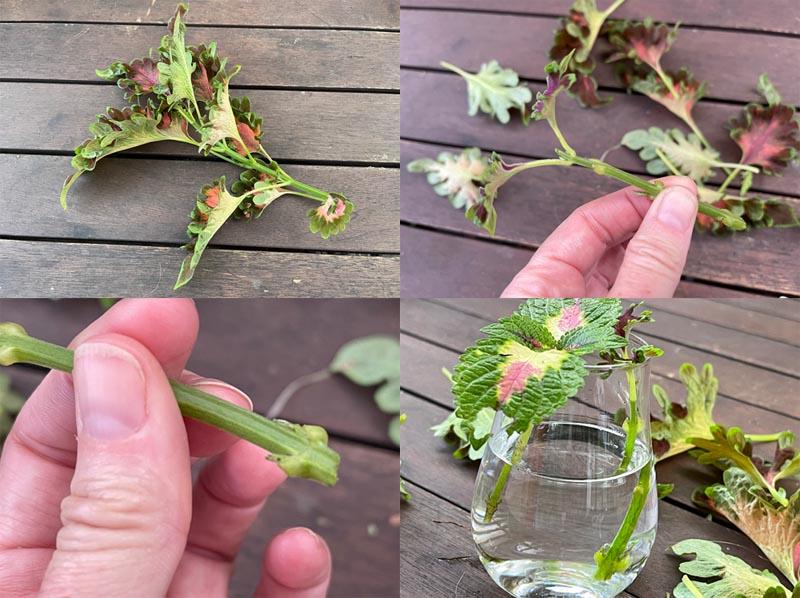
Coleus propagated indoors will need to be hardened off to accustom the cuttings to outdoor conditions and prevent shock. To do this, place the cuttings outside in a sheltered location for a week and protect them from the sun and wind.
Pests and diseases
Root rot (Pythium spp. and Rhizoctonia solani)
Root rot is a common disease caused by Pythium spp. or Rhizoctonia solani which thrive in moist soil. Both pathogens infect fine roots and root hairs, killing them off. The plant will develop yellowing of the leaves, develop stem lesions near the base of the plant, and the ordinarily white roots turn brown and soggy.
Downy mildew (Peronospora spp.)

Downy mildew is a disease caused by an oomycete or water mould which is an obligatory parasite that can have a devastating impact on affected plants. Affected leaves have a white, grey or brown soft-looking fuzz, develop a yellow-brown or mottled appearance and become curled or twisted. Plants should be spaced well enough apart to allow air to circulate freely and avoid overhead watering.
If you suspect your plant has downy mildew, remove it, place it in a plastic bag and dispose of it in the garbage to avoid spreading the disease to other plants.
Foliar nematodes (Aphelenchoides)
Parasitic worms that live and move in water films and can be found in inhabiting tropical regions. Almost all above-ground parts of the plant can be affected. Infested plants develop discoloured yellow-brown spots on the leaves, which gradually affect the entire leaf. Seriously affected leaves wither and die. Under moist and humid conditions, the symptoms can rapidly spread up the plant, with new leaves emerging from infested shoots appearing distorted and thickened, and small, malformed flowers.
Toxicity
Coleus is mildly toxic to cats, dogs and people. The toxic principles are volatile essential oils and an irritant sap which can cause gastrointestinal disturbances and mild dermatitis. Ingestion of coleus causes can lead to nausea, vomiting, diarrhea, depression, loss of appetite and contact with the sap can cause contact dermatitis.
Photo gallery
Frequently asked questions?
How long do coleus plants live?
This depends on your location, in cooler climates, coleus is grown as annuals. For coleus grown in tropical climates, plants can last for several years.
Is coleus an indoor or outdoor plant?
Coleus can be grown as both an indoor and an outdoor plant. However, coleus prefers warm temperatures and is grown as an annual in cooler climates, or brought inside until the risk of frost has passed.
Do coleus plants bloom?
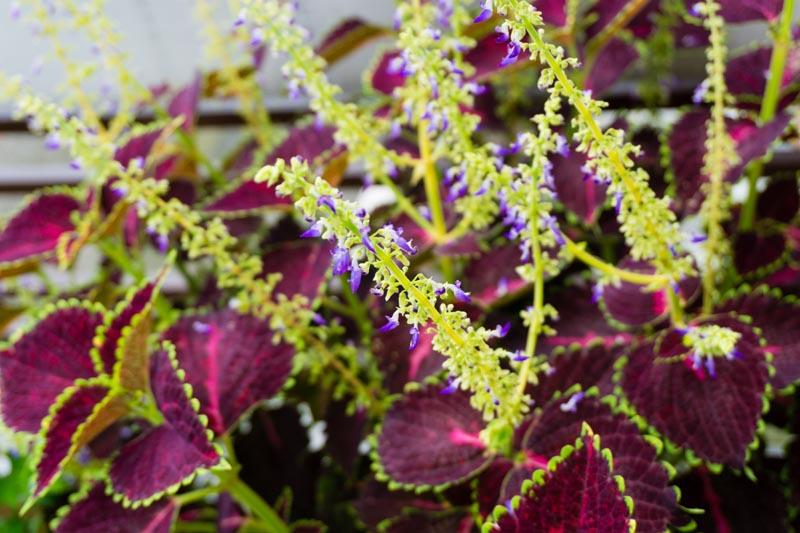
Coleus plants produce white or purple flowers in late autumn, however, most gardeners recommend cutting the flowers off so the plant doesn’t focus its energy on seed production.
How to fix a leggy coleus?
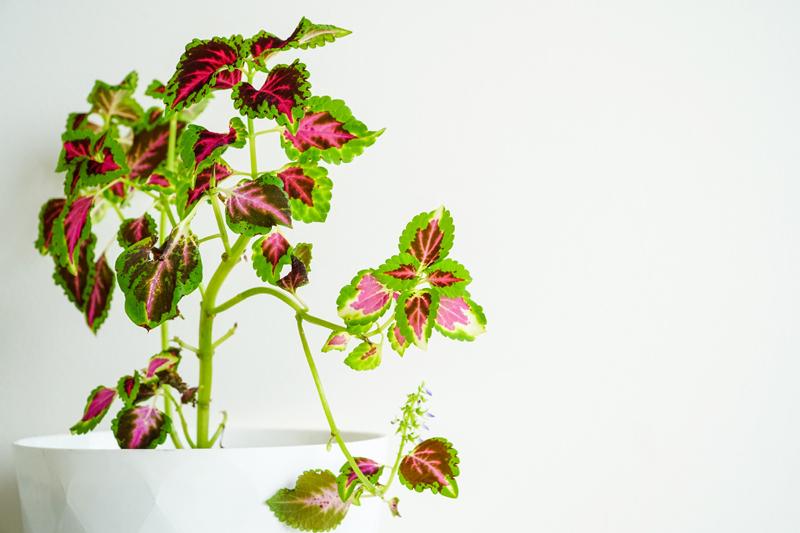
Coleus plants are prone to becoming leggy. The good news is that a hard prune will solve legginess in coleus. Use a sharp, clean pair of scissors or secateurs and prune the plant to the desired height. Coleus can take a hard prune and will bounce back quickly.
Does coleus do better in pots or in the ground?
Some plants can be fussy, especially if grown in pots. My experience is that coleus grows well in pots or in the ground. Potted coleus plants generally require more frequent watering than those grown in the ground.
How to make coleus bushy
Tall coleus can be pruned hard to promote a bushier plant. Smaller coleus should be tipped (pinched), which will cause the plant to grow side shoots, which will make the plant bushier. Always sanitise your hands and equipment before pinching out plants to reduce the risk of infection.
Ensure you pinch the coleus just above the node (marked with a red X in the image below), this will cause the plant to push out side shoots.
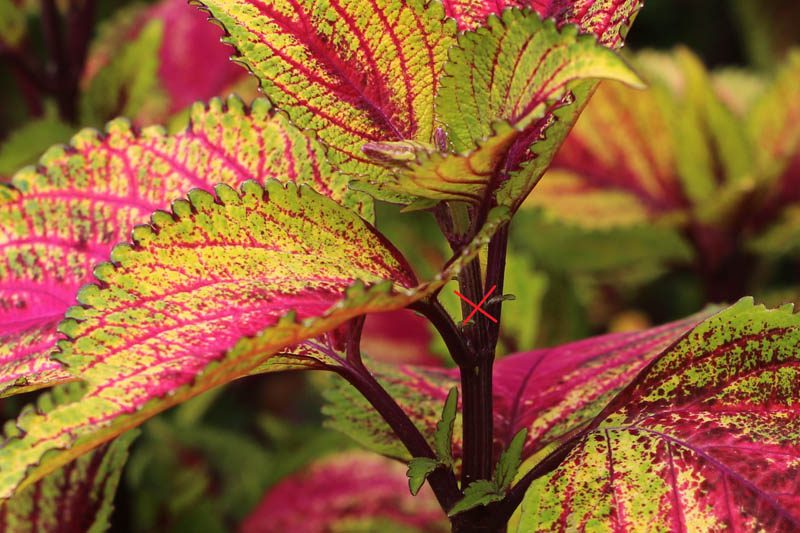
Julia is a writer and landscape consultant from Wollongong with a love of horticulture. She had been an avid gardener for over 30 years, collects rare variegated plants and is a home orchardist. Julia is passionate about learning and sharing her knowledge of plant propagation and plant toxicology. Whether it’s giving advice on landscape projects or sharing tips on growing, Julia enjoys helping people make their gardens flourish.












